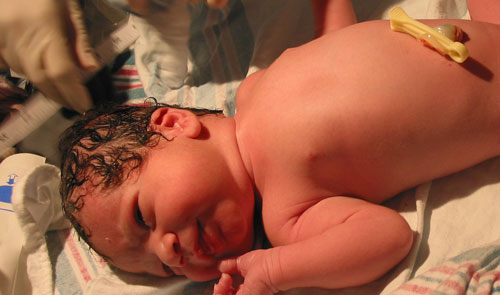Cerebral Palsy
Types of Cerebral Palsy Classified by Movement Disorder
Spastic Cerebral Palsy

What is Spastic Cerebral Palsy?
To understand what the term Spastic Cerebral Palsy means and the type of Cerebral Palsy to which it refers, one must first understand what the term Spastic means in the context of medical terminology.
Spastic: The term Spastic means “of, relating to, characterized by, or affected by Spasm or Spastic Paralysis.”
Spasm: Spasm is a sudden, involuntary contraction of a muscle or group of muscles. The American Heritage® Stedman's Medical Dictionary
Spastic Paralysis: Spastic Paralysis is a loss or deficiency of motor control with involuntary spasms caused by permanent brain damage present at birth.
Cerebral Palsy is a permanent, disabling condition that results from permanent brain damage caused during delivery, permanent brain damage caused at birth, or permanent brain damage caused shortly after birth.
Spastic Cerebral Palsy is a type of Cerebral Palsy characterized by symptoms of Spasm and Spastic Paralysis as the result of permanent brain damage caused during delivery, permanent brain damage caused at birth, or permanent brain damage caused shortly after birth.
Spastic Cerebral Palsy occurs more often than any other type of Cerebral Palsy. Spastic Cerebral Palsy affects more than half (some estimate up to 80%) of those who suffer from Cerebral Palsy.
[Back to Top]
Types of Medalpractice
Medical Malpractice during Labor and Delivery, or Shortly after Birth
Cerebral Palsy
Types of Cerebral Palsy Classified by Movement Disorder
Spastic Cerebral Palsy
How Does Spastic Cerebral Palsy Interfere with Movement?
Because spastic muscles are tight and stiff, they are harder to stretch. Because spastic muscles are harder to stretch, they become overactive when used and produce clumsy movements. The permanent brain damage that results in Spastic Cerebral Palsy causes muscles to be overactive and, as a result, cause movements supported by spastic muscles to be clumsy.
Normal muscles work in pairs. When one group of normal muscles tighten and contract, the opposing group of muscles loosens and relaxes. The normal relaxing of the muscle groups opposite from the muscle group tightening allows free movement. For example, when you tighten your bicep muscle (the muscle on top of you arm between your shoulder and your elbow), your triceps muscle (the muscle underneath your arm from your shoulder to your elbow) loosens and relaxes. If you pout your arm straight out in front of you with your palm facing up, touch the muscle below your arm between your shoulder and elbow, and then, while still touching the underside of your arm, touch your forehead with your other hand, you will see that the muscles under you arm are loose and relaxed. Now put your arm straight out in front of you and use the other hand to touch the muscle on the top side of your arm between your shoulder and elbow instead of touching the bottom side like you just did before. Now, when you touch your forehead, you will feel the muscle on the top of your arm flex and contract.
The tightening and loosening of opposite muscle groups allow free movement in the direction intended. For someone who suffers from Spastic Cerebral Palsy, opposite muscles often flex and contract together at the same time. When the brain damage characterized by Spastic Cerebral Palsy causes opposite muscle groups to flex and contract together at the same time, the intended movement is blocked. Instead of free movement, a sort of "tug-of-war" occurs between the opposite muscle groups. The muscular "tug-of-war" that characterizes Spastic Cerebral Palsy is called “co-contraction.”
[Back to Top]
prTypes of Medical Malpractice
Medical Malactice during Labor and Delivery, or Shortly after Birth
Cerebral Palsy
Types of Cerebral Palsy Classified by Movement Disorder
Spastic Cerebral Palsy
What Causes Spastic Cerebral Palsy?
Cerebral Palsy is the result of permanent brain damage suffered during delivery, permanent brain damage suffered at birth, or permanent brain damage suffered shortly after birth. One type of Cerebral Palsy that results from permanent brain damage suffered during delivery, permanent brain damage suffered at birth, or permanent brain damage suffered shortly after birth is Spastic Cerebral Palsy. Most often, Spastic Cerebral Palsy is caused by permanent brain damage to the cerebral cortex suffered during delivery, permanent brain damage to the cerebral cortex suffered at birth, or permanent brain damage to the cerebral cortex suffered shortly after birth.
The severity of the Spasticity resulting from the permanent brain damage suffered during delivery, the permanent brain damage suffered at birth or the permanent brain damage suffered shortly after birth, that gave rise to Spastic Cerebral Palsy may vary greatly.
[Back to Top]
Cerebral Palsy
Types of Cerebral Palsy Classified by Movement Disorder
Spastic Cerebral Palsy
Do Cases of Spastic Cerebral Palsy Vary in Severity?
Yes. Cases of Spastic Cerebral Palsy can vary from cases of Mild Spastic Cerebral Palsy to cases of Severe Spastic Cerebral Palsy. The severity of the permanent brain damage suffered during delivery, permanent brain damage suffered at birth, or permanent brain damage suffered shortly after birth permanent influences the severity of the case of Spastic Cerebral Palsy.
[Back to Top]
Spastic Cerebral Palsy
Do Cases of Spastic Cerebral Palsy Vary in Severity?
Mild Spastic Cerebral Palsy Cases
Some cases of Spastic Cerebral Palsy are classified as cases of Mild Spastic Cerebral Palsy. In cases of Mild Spastic Cerebral Palsy, the permanent brain damage suffered during delivery, the permanent brain damage suffered at birth, or the permanent brain damage suffered shortly after birth that causes the Spastic Cerebral Palsy is considered to be mild. In mild cases of Spastic Cerebral Palsy, only a few movements are affected by the permanent brain damage suffered during delivery, the permanent brain damage suffered at birth, or the permanent brain damage suffered shortly after birth.
[Back to Top]
Spastic Cerebral Palsy
Do Cases of Spastic Cerebral Palsy Vary in Severity?
Severe Spastic Cerebral Palsy Cases
Some cases of Spastic Cerebral Palsy are classified as cases of Severe Spastic Cerebral Palsy. In cases of Severe Spastic Cerebral Palsy, the permanent brain damage suffered during delivery, the permanent brain damage suffered at birth, or the permanent brain damage suffered shortly after birth that causes the Spastic Cerebral Palsy is severe. In cases of Severe Spastic Cerebral Palsy, movements throughout the entire body are affected by the permanent brain injury suffered during delivery, the permanent brain suffered at birth, or the permanent brain damage suffered shortly after birth.
[Back to Top]
Spastic Cerebral Palsy
Do Cases of Spastic Cerebral Palsy Vary in Severity?
Does the Severity of Spasticity ever Change in Cases of Spastic Cerebral Palsy?
In cases of Spastic Cerebral Palsy, the severity amount of spasticity usually changes over time.
[Back to Top]
Spastic Cerebral Palsy
Do Cases of Spastic Cerebral Palsy Vary in Severity?
What can be done to help control the severity of cases of Spastic Cerebral Palsy?
There are several types of treatment available to help control the severity of cases of Spastic Cerebral Palsy. The treatments available to help control the severity of cases of Spastic Cerebral Palsy include physical therapy, surgery, medications, and adaptive equipment. While the permanent brain damage suffered during delivery, the permanent brain damage suffered at birth, or the permanent brain damage suffered shortly after birth that causes the Spastic Cerebral Palsy cannot be healed, available treatments may help to control the symptoms of spasticity that result from the permanent brain damage suffered during delivery, the permanent brain damage suffered at birth, or the permanent brain damage suffered shortly after birth.
[Back to Top]
Where may we take you?
To learn about Birth Injuries and Delivery Malpractice, Click Here.
To learn more about Cerebral Palsy, Click Here.
To fill out our Free Online Questionnaire, Click Here.
To return the the Hurt by a Doctor homepage, Click Here.


